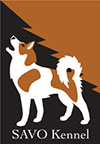Considerations for Breeding
There has been a great deal of time and effort put forth to establish the foundation stock of Savo Kennel. Genetic diversification, health, hunt drive, and temperament are considerations addressed prior to planning a litter.
Genetic Diversity
The Norrbottenspets in North America has a very limited gene pool and variation is needed. Both of Savo’s dogs offer unique pedigrees. You can go to each dogs individual page to view their pedigree.
Health Considerations
According to insurance companies such as Agria in Sweden and its Finnish branch Tapiola, the Norrbottenspets is one of the healthiest breeds to own with low incidental risks. They are as vigorous and robust as other breeds recently derived from landraces.
The few health issues that need to be watched for in this breed are patellar subluxation, early onset cataracts, and epilepsy. I am very fortunate that there is ongoing health data being collected for this breed, by the Finnish Kennel Club. As both my dogs are Finnish registered I can take advantage of the information provided to help determine my risk factors when breeding.
To follow with the work of the FKK, I also health test my dogs. They are tested for early onset cataract, patellar subluxation, and hip dysplasia. Presently there is no test for Epilepsy but with the information given by the FKK the likelihood of occurrence in breeding pair’s offspring can be calculated based on knowing the affected and assigning values to parents, siblings, and relatives. Direct health test results combined with family tree health information is a good start for determining the potential outcome for healthy pups.
Hip dysplasia is not a common occurrence in this breed. This is quite fortunate and to preserve this hardiness we screen for it as a preventative measure.
(I would like to note that the American Norrbottenspets Association, an official supporter of Canine Epilepsy research, done by the University of Missouri, is hopeful a screening test for seizures can be offered in the near future.)
Hunting Drive
Hunt drive is a term that needs some definition to be able to describe what we are looking for in a dog. It is often used synonymously with prey drive. Both terms are used to describe high drive dogs that have focus on tasks for reward – food or a toy. This is not our definition for “hunt drive”.
Many dogs having high drive, have been far removed from the hunting world and their inspirational focus has been bred to find reward from human interaction. If these dogs were put in a true hunting scenario they may or may not succeed. I have seen this time again in dogs that are from a particular hunting breed, but come from far removed hunting lines, not being able to perform in the field.
”Hunt drive”, then, is an inherent line character, and when not used, can be lost in subsequent offspring, the farther removed they are from the breed’s original purpose. Your chances of getting a good hunting dog from good hunting lines are far better than non hunting lines. Similarly, your chances of getting a good obedience dog from good obedience dog lines is far better than non obedience dog lines. The odds of success for acquiring a dog for your purpose are best achieved if you focus on a mated pair with these qualities and, even better, acquiring a pup from a line of successful relations.
Our definition of “hunt drive” then is true to it’s source – being a dog that can perform as a hunting dog, in the field, and is actively used for such purpose. These dogs, when bred, pass on their inherent quality and your percentage of success for their offspring, in this role, is greater. Hunt drive is a focus of our breeding program and we have dogs that come from proven hunting lines. My breeding pair were chosen for this quality. We are confident that the pups will show promise in this regard.
Temperament
Our emphasis is breeding for the standard – attentive and daring, alert, kind, and self-assured. From what I’ve seen this is a breed with a stable temperament. They are respectful of strangers and can be somewhat aloof but remain loyal to family members. We wish to maintain these qualities and breed for them.
References
Saman’s Kennel. “Epilepsy in Finnish Spitz.” Accessed March 25, 2015: http://www.samans.fi/Helmi/epilepsy.html
Bob having fun!


